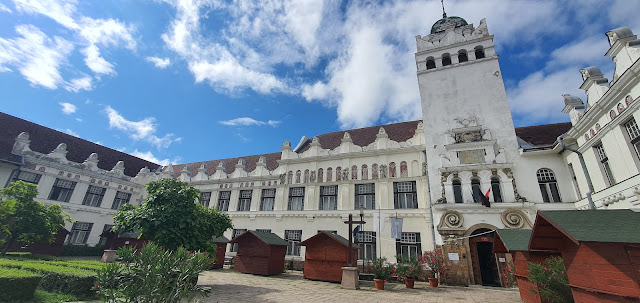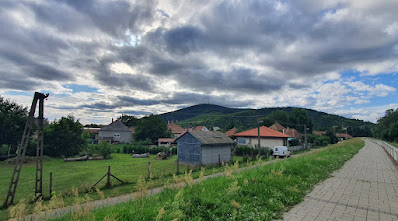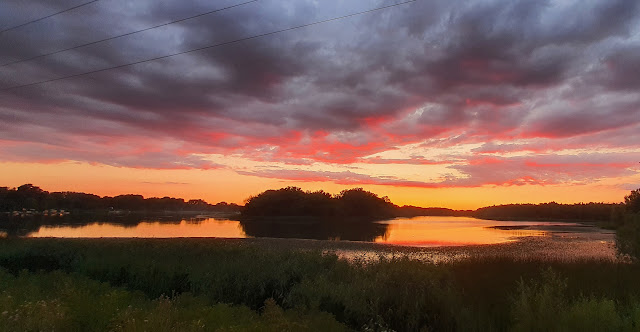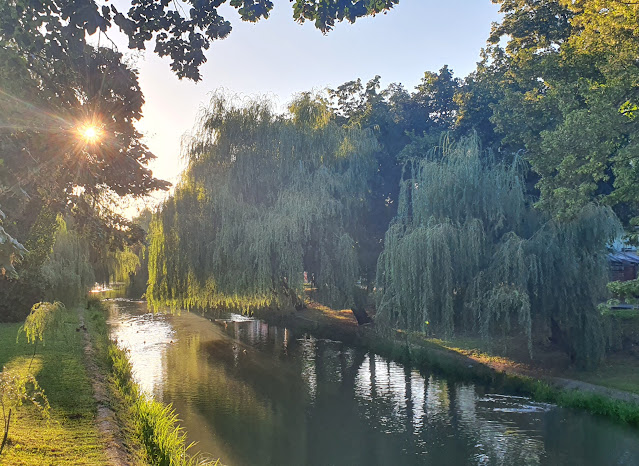Wine and wild beasts
Hungary kept raining on us relentlessly.
Thinking that if there is water from above, maybe water from below would be the right course to take, we went do Miskolc, apparently one of the best thermal spas in the country.
Well, we never got a chance to find out. After standing in line, in the rain, for 45 minutes without anyone in front of us being let in, but plenty of people coming out, and the line behind us getting longer and longer, my human had enough and left, only slightly frustrated…
We then drove on to Sarospataki. Just a few kilometers out of town lies the Megyer Hill Tarn, a man made lake that used to be a millstone mine. The lake is only 6 meters deep but the rock faces around it stand up to 70 meters tall - a must see, weˋve been told.
Not letting the weather deter her, my human went on a walk in the surrounding woods regardless and came back with the hood of her rain jacket full of blackberries.
Something to lighten up the mood!
 |
| The cityˋs town hall |
 |
| When was Gaudi here? |
There are no reds, as the law only allows white wines to be produced here.
Tokaj aszu is the most famous of them all. It is basically made out of rotten grapes, has a sugar content somewhere up from 160 grams per liter and is quite delicious, as we found out in a wine tasting.
The six wines we tried went from 1,9 grams of sugar to the above mentioned. Letˋs just say that the first four were not so much to our taste.
After a run and a hike up to a view point the next morning, we finally found a spa that actually let people in. And thatˋs where my human spent the second half of the day.
 |
| From below |
 |
| From above |
Breaking out the shorts again, my human took the bike into Debrecen the following day.
Debrecen is the second most populous city in Hungary, with a bit over 200.000 inhabitants.
Towering over the main square, Kossuth ter, is the neoclassical Reformed Great Church. You can climb the bell towers for a nice view over the city.
 |
| The first Hungarian translation of the bible |
 |
| A rather austere interiour |
We were looking for (and finding) a butcher, though. Since we were in Debrecen, we had to buy some Debrecen sausages, right?
Only interesting at night, though, so during the day itˋs really just a fountain.
 |
| A water tower turned cafè, climbing wall, view point |
A much larger park close to the city is the Horobagy National Park, Hungaryˋs first and largest, 820 square kilometers of it.
The name might not sound familiar, who could blame you, but you will have heard of the Puszta. This is it.
A treeless alkaline grassland dominates the landscape, making it the perfect grazing ground for grey cattle, Przewalskiˋs wild horses, aurochs and Racka sheep.
There is almost no permanent human population within the park. Only during grazing season, from April to October, hundreds of stock breeders graze their animals here.
And so my human went from 130 horse power, thatˋs me, to two, namely two horses towing a carriage through the Puszta, to see some of the aforementioned creatures.
 |
| The origins of vaulting? |
 |
| They didnˋt look very motivated... |
 |
| A horse sitting down is one of the sillier sights you can see in Hungary |
 |
| Water buffalo, each as strong as four horses |
 |
| Grey cattle |
 |
| Racka sheep |
It seems like you canˋt just go off on your own, walking around, exploring. They are afraid on of the grey cattle might have it in for you and take you on its horns. Granted, thatˋs not a very pleasant idea.
There are three areas designated for walking, though. By far the largest one is situated around a huge area with fish ponds where thousands of birds live, as well as water buffalo. And there are no people at all, none!
I guess it looks different in autumn when the cranes are migrating through this area, but right now itˋs empty.
Here we booked into Dieterˋs Campground. Never mind that Dieter died in 2015, as a picutre at reception will tell you.
Itˋs all but two minutes to the lake from here, which can be circumnavigated by bike on a designated 65km cycle path.
Which is just what my human had in mind.
 |
| Water bungalow Hungarian style |
 |
| Kisköre fish ladder, the largest ecological corridor in Central Europe |
After watching two quarter finals (GO AUSTRALIA!) of the Womenˋs World Cup, we made our way to Gyula, a wonderfully unpretentious, charming little town only 5km from the Rumanian border, which is know for - asolutely nothing, actually.
We arrived in time for a nice little walk before dinner and went back into town after to listen to some live music in front of the castle. Good spot for some entertainment!
PS:
Things that seem (to us) quintessentially Hungarian:
Watermelons
Sunflowers
Thermal baths
Storks
All of these are absolutely everywhere!































































Comments
Post a Comment